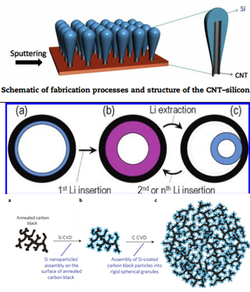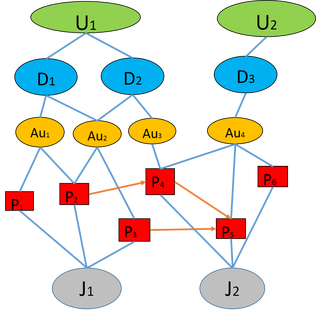
Various Nanostructure for Electrodes
-Coating
-Core-shell
-Encapsulation
-Coating
-Core-shell
-Encapsulation
Nano science is now investigated by a large amount of researchers in Chemistry, Physics, Materials Science and Mechanical Engineering. etc. Lithium ion battery is one of field catches most nano scientists's attention. Nano electrode is the core of innovation. According to Web of Science, there are 624 research papers focus on "nano+electrode+lithium-ion" topic.
I respect material scientist in the aspect that they have invented a large amount of electrode with different materials, geometries, and combination methods. Then these electrodes are labeled with different features. From my observation, most material scientists' work on electrode include material fabrication, characterization and performance test. The focus lies on the fabrication and characterization of nano electrode. The mechanism study is limited and only based on certain set of electrodes. What's more there is no systematic research on the functionality of different features. Which feature is more important? How could we locate the optimal? When I was doing literature review, those questions bother me a lot.
A natural thinking is could we use statistical method (like regression) and literature data to locate the powerful features, to find out which of nanowire and nano particle is more useful? Review papers offered a half-processed data pool, and a larger data pool would be the 624 papers emerging last year. To test the statistical model, we may use limited sets of data with limited features. For example, I am studying the silicon-carbon anodes for LIB. Then gradually, we move to the multi-dimensional design, with varying materials, geometries, combinations and even fabrication process. To enhance the robustness with most simple model, we need to have a pre-selection of the sensitive features, which might be done machine learning and data mining methods (like rough set) for larger data pool. The functionality model will offer the weight of different functionality to the performance, which may shed light on the explanation of the mechanism.
After we had the basic understanding of the functionality, we would also get interested in how could we generate new electrode with the data pool. The design of electrode is actually a discrete multi-variable optimal problem. If the variables are limited, it can be reached by a searching method. But without that, we could only try different combinations. I think we could introduce a framework of using idea matrix and innovation operator to genetically generate the new electrodes. This part is still not well-thought especially when I am doing dual projects already.
I respect material scientist in the aspect that they have invented a large amount of electrode with different materials, geometries, and combination methods. Then these electrodes are labeled with different features. From my observation, most material scientists' work on electrode include material fabrication, characterization and performance test. The focus lies on the fabrication and characterization of nano electrode. The mechanism study is limited and only based on certain set of electrodes. What's more there is no systematic research on the functionality of different features. Which feature is more important? How could we locate the optimal? When I was doing literature review, those questions bother me a lot.
A natural thinking is could we use statistical method (like regression) and literature data to locate the powerful features, to find out which of nanowire and nano particle is more useful? Review papers offered a half-processed data pool, and a larger data pool would be the 624 papers emerging last year. To test the statistical model, we may use limited sets of data with limited features. For example, I am studying the silicon-carbon anodes for LIB. Then gradually, we move to the multi-dimensional design, with varying materials, geometries, combinations and even fabrication process. To enhance the robustness with most simple model, we need to have a pre-selection of the sensitive features, which might be done machine learning and data mining methods (like rough set) for larger data pool. The functionality model will offer the weight of different functionality to the performance, which may shed light on the explanation of the mechanism.
After we had the basic understanding of the functionality, we would also get interested in how could we generate new electrode with the data pool. The design of electrode is actually a discrete multi-variable optimal problem. If the variables are limited, it can be reached by a searching method. But without that, we could only try different combinations. I think we could introduce a framework of using idea matrix and innovation operator to genetically generate the new electrodes. This part is still not well-thought especially when I am doing dual projects already.

 RSS Feed
RSS Feed
